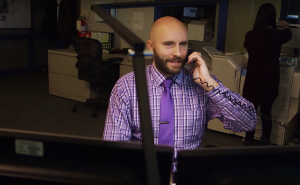How TransLink Learned to Connect the World to the Olympic Games One Tweet at a Time
How TransLink Learned to Connect the World to the Olympic Games One Tweet at a Time

Few people know that the 2010 Olympics played a major role in getting the ball rolling on connecting our customer with transit information in real time via Twitter. The games inspired the Twitter pilot project in Fall 2010, and laid the foundation for how we communicate online with over 200,000 customers today. We sat down with Derek Zabel, Manager at Compass Operations Solutions and one of the main initiators of the Olympics pilot project on Twitter , to take a walk down the memory lane and see how everything started.

TransLink’s Twitter was around for so long that it’s difficult to imagine TransLink’scustomer service without it. Can you tell us more about how it all began?
Back in 2010, I was working on the Media Relations team with Coast Mountain Bus Company. Winter Olympics brought thousands of people to Vancouver and our team worked hard to make sure we could engage with the visitors and our regular customers in a timely and efficient manner.
The idea was sparked by our Director of Communication at the time, Ken Hardie. He wanted to connect to customers on a completely new platform. So during that time we had some discussions between Ken, others and myself – what can we do to equip people with as much information about transit as possible?
Twitter during that time was a place for people to get information from news media. Initially we planned to use Twitter to communicate with the press. But when we looked at the other transportation agencies, no one was really utilizing Twitter for customer service, so we kind of took a risk.
What were your team’s main objectives with getting Twitter running?
We really wanted to ensure that our customers would have all the information they needed at their fingertips. We wanted to inform them about all the different service delays, numerous buses that we brought in to try to get people to various venues. And, most importantly, we wanted to make sure we can engage with them almost instantaneously. If anyone had a question about transportation or logistics for the Olympics events, we were on top of it and ready to respond. Our main goal was to make sure everyone could get to their end destinations, whether it was a hockey game, training locations or their homes.
How was the Twitter Team set up?
During the Olympics, I was an acting Director of Communications for a couple of weeks and had a small team of about four people. We would come in at 6 o’clock at night and would leave at about 6 in the morning. That was because various events in the city, including hockey games, were happening in the evening. We each had Tweet Deck set up and we had all those different streams lined up. We’d pick up hashtags and reply to people who’d mention us.
What were you main challenges?
Having small teams communicating with thousands of new visitors was one of the main challenges. At the end of the day, Olympics for us was really about engagement and connection. We wanted to leave a good impression about Vancouver and our transportation system and ensure our customers’ experience of transit was as seamless as possible so they could enjoy the events. It was a real chance for our organization to shine. Of course, service delays and changes happened too. But our task was always to respond to customers instantaneously. Even if they were saying something about it negatively, it did not matter. We would reach out to them saying “You know we’re sorry you cannot get on that bus, but there is another one coming and it has more space or something like that”. And I think that made a very good inroads to our customers and helped us to navigate through the major challenges.
What do you think was the legacy of this project on how we communicate with customers today?
Our initiative was so successful that it encouraged TransLink to roll out a month-long Twitter pilot project later that year and was subsequently handed over to the Customer Information team. After the Olympics, a lot of organizations were reaching back to us with positive feedback. I think we broke the ground on trying to engage with customers socially and in real-time fashion for a lot of transportation agencies across the world. We started with a few hundred followers and ten years later our Twitter following is phenomenal.
Today our Customer Information team provides updates about TransLink buses, SeaBus, SkyTrain, Handy DART, and WestCoast Express, responding to over 100 questions on Twitter daily and keeping an eye on important alerts. Do you follow @TransLink on Twitter? Perhaps you were around in 2010 and have a story about your engagement with us on Twitter? If so, let us know – we’d love to hear about it! Who knows, maybe we’ll get the Olympics again.





